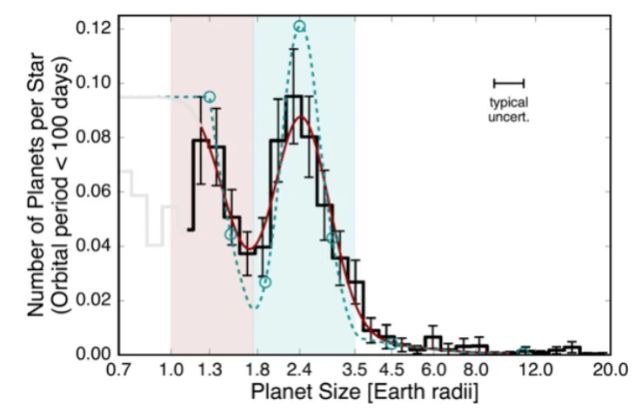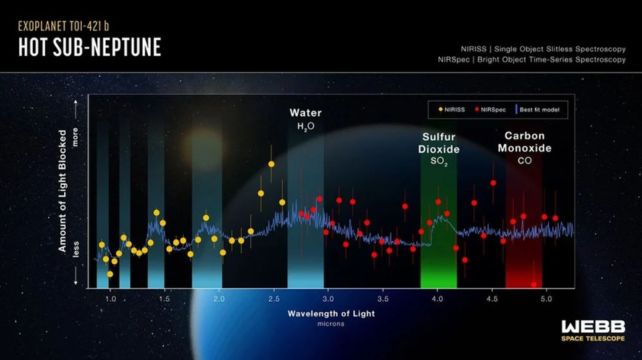The idea that our Solar System is representative of other solar systems hasn’t survived the age of exoplanet discovery.
Kepler and TESS have shown us that our system doesn’t even contain the most common type of planet: sub-Neptunes. These planets pose a mystery to planetary scientists, and the JWST is helping unravel the mystery.
Sub-Neptunes are exoplanets with larger radii than Earth but smaller radii than Neptune. Most sub-Neptunes have hazy atmospheres and are challenging to observe.
However, the JWST’s infrared observing capabilities are helping exoplanet scientists understand these ubiquitous worlds.
The origins of these planets are mysterious, and understanding why there are so many of them is key research in exoplanet science. Not only are they plentiful, but astronomers found one star orbited by six of them.

Most sub-Neptunes have been found orbiting small, cool M-dwarfs, or red dwarfs. However, one of them, TOI-421b, is orbiting a G-type star, a star very similar to the Sun.
The planet’s temperature is important in this research. It is several hundred degrees Fahrenheit higher than the threshold for chemical reactions that create the haze sub-Neptunes are known for, making it a desirable target for the JWST.
New research in The Astrophysical Journal Letters presents the result of the JWST’s observations. It’s titled “TOI-421 b: A Hot Sub-Neptune with a Haze-free, Low Mean Molecular Weight Atmosphere.“
The lead author is Brian Davenport from the Department of Astronomy at the University of Maryland. Co-author Eliza Kempton is from the same department and is a principal investigator for the JWST.
“I had been waiting my entire career for Webb so that we could meaningfully characterize the atmospheres of these smaller planets,” said Kempton.
“By studying their atmospheres, we’re getting a better understanding of how sub-Neptunes formed and evolved, and part of that is understanding why they don’t exist in our solar system.”
Scientists are keen to understand why they don’t exist here because the answer is related to how they form. One of the puzzling things about the exoplanet population is the “radius gap” or “radius valley.”

There’s a relative scarcity of planets with sizes between roughly 1.5 and 2.0 Earth radii, and planets tend to be either smaller super-Earths or larger sub-Neptunes. Planets may initially form in the gap or valley, but may suffer atmospheric loss due to stellar radiation and become super-Earths.
Sub-Neptunes are difficult to observe compared to other exoplanet types. Prior to the JWST, astronomers had scant information on them. Observations showed that they had relatively flat and featureless transmission spectra.
That means nothing stood out, and there were no visible chemical fingerprints. Astronomers concluded that the planets had thick haze and clouds.
“It is strongly suspected that photochemical haze is to blame for the muted spectra,” Kempton and her co-researchers explained in their JWST observation proposal.
“Such hazes are predicted to form over a limited temperature range – primarily below 850 K. The implication is that planets hotter than this cutoff temperature should be free of obscuring hazes and should present clear atmospheres that are ideal for atmospheric investigations.
“To that end, we propose to obtain the transmission spectrum of TOI421b – the highest S/N sub-Neptune that is hot enough (Teq~1,000 K) to expect haze-free conditions.”
TOI-421b, with its higher-than-normal temperature for a sub-Neptune, offered a chance for a better look at sub-Neptunes.
“Why did we observe this planet, TOI-421 b? It’s because we thought that maybe it wouldn’t have hazes,” said Kempton. “And the reason is that there were some previous data that implied that maybe planets over a certain temperature range were less enshrouded by haze or clouds than others.”
The JWST came through and delivered a spectrum of the exoplanet’s atmosphere.

“We saw spectral features that we attribute to various gases, and that allowed us to determine the composition of the atmosphere,” said lead author Davenport, a third-year Ph.D. student who conducted the primary data analysis.
“Whereas with many of the other sub-Neptunes that had been previously observed, we know their atmospheres are made of something, but they’re being blocked by haze.”
The researchers were surprised to find that the JWST’s results suggested an atmosphere with a large amount of hydrogen.
“We had recently wrapped our minds around the idea that those first few sub-Neptunes observed by Webb had heavy-molecule atmospheres, so that had become our expectation, and then we found the opposite,” said Kempton.
The implication is that TOI-421 b may have formed and evolved differently from cooler sub-Neptunes.
The JWST’s findings show that TOI-421 b’s atmosphere mimics its star’s composition.
“If you just took the same gas that made the host star, plopped it on top of a planet’s atmosphere, and put it at the much cooler temperature of this planet, you would get the same combination of gases. That process is more in line with the giant planets in our solar system, and it is different from other sub-Neptunes that have been observed with Webb so far,” said Kempton.
In their paper’s conclusion, the authors discuss the implications of these findings. Exoplanet scientists think that sub-Neptunes and super-Earths both start out as rocky cores that attract hydrogen atmospheres from the solar nebula. Exposure to their stars’ radiation worked to strip away their atmospheres, and core-driven mass loss could’ve contributed, too.
The sub-Neptunes had more massive cores and held onto their atmospheres, while the super-Earths didn’t. That can explain the radius valley.
frameborder=”0″ allow=”accelerometer; autoplay; clipboard-write; encrypted-media; gyroscope; picture-in-picture; web-share” referrerpolicy=”strict-origin-when-cross-origin” allowfullscreen>
“These findings, along with our inferred bulk ~1 percent H/He mass fraction, imply that TOI-421 b hosts a primordial atmosphere, in line with predictions that the radius valley is shaped by mass-loss processes,” the authors write in their conclusion.
“The tantalizing differences between the properties of TOI-421 b’s atmosphere and those of other JWST-observed sub-Neptunes orbiting late K and M dwarf stars indicate the need for further study of objects in this class,” they write.
These results pose clear questions: Are other hot sub-Neptunes orbiting Sun-like stars similar? Or is TOI-421 b a one-off, and are exoplanet populations just diverse? Only more observations can tell us.
“We’ve unlocked a new way to look at these sub-Neptunes,” said Davenport.
“These high-temperature planets are amenable to characterization. So by looking at sub-Neptunes of this temperature, we’re perhaps more likely to accelerate our ability to learn about these planets.”
This article was originally published by Universe Today. Read the original article.

